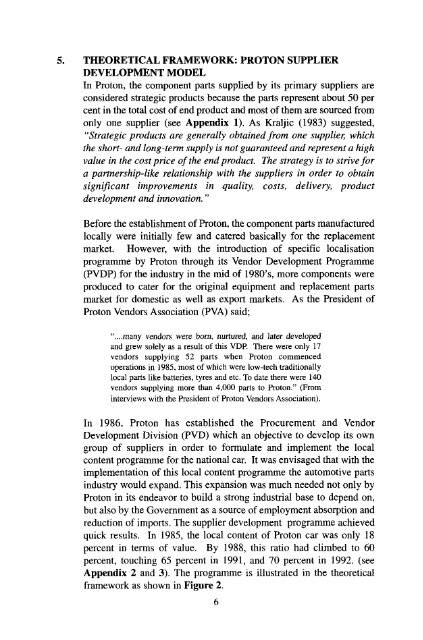(jit) principles and systematic layout planning as tools to improve ...
(jit) principles and systematic layout planning as tools to improve ...
(jit) principles and systematic layout planning as tools to improve ...
You also want an ePaper? Increase the reach of your titles
YUMPU automatically turns print PDFs into web optimized ePapers that Google loves.
5. THEORETICAL FRAMEWORK: PROTON SUPPLIER<br />
DEVELOPMENT MODEL<br />
In Pro<strong>to</strong>n, the component parts supplied by its primary suppliers are<br />
considered strategic products because the parts represent about 50 per<br />
cent in the <strong>to</strong>tal cost of end product <strong>and</strong> most of them are sourced from<br />
only one supplier (see Appendix 1), As Kraljic (1983) suggested,<br />
"Strategic products are generally obtained from one supplier, which<br />
the short- <strong>and</strong> long-term supply is not guaranteed <strong>and</strong> represent a high<br />
value in the cost price of the end product. The strategy is <strong>to</strong> strive for<br />
a partnership-like relationship with the suppliers in order <strong>to</strong> obtain<br />
significant <strong>improve</strong>ments in quality, costs, delivery, product<br />
development <strong>and</strong> innovation."<br />
Before the establishment of Pro<strong>to</strong>n, the component parts manufactured<br />
locally were initially few <strong>and</strong> catered b<strong>as</strong>ically for the replacement<br />
market. However, with the introduction of specific localisation<br />
programme by Pro<strong>to</strong>n through its Vendor Development Programme<br />
(PVDP) for the industry in the mid of 1980's, more components were<br />
produced <strong>to</strong> cater for the original equipment <strong>and</strong> replacement parts<br />
market for domestic <strong>as</strong> well <strong>as</strong> export markets. As the President of<br />
Pro<strong>to</strong>n Vendors Association (PVA) said;<br />
"....many vendors were born, nurtured, <strong>and</strong> later developed<br />
<strong>and</strong> grew solely <strong>as</strong> a result of this VDP. There were only 17<br />
vendors supplying 52 parts when Pro<strong>to</strong>n commenced<br />
operations in 1985, most of which were low-tech traditionally<br />
local parts like batteries, tyres <strong>and</strong> etc. To date there were 140<br />
vendors supplying more than 4,000 parts <strong>to</strong> Pro<strong>to</strong>n." (From<br />
interviews with the President of Pro<strong>to</strong>n Vendors Association).<br />
In 1986, Pro<strong>to</strong>n h<strong>as</strong> established the Procurement <strong>and</strong> Vendor<br />
Development Division (PVD) which an objective <strong>to</strong> develop its own<br />
group of suppliers in order <strong>to</strong> formulate <strong>and</strong> implement the local<br />
content programme for the national car. It w<strong>as</strong> envisaged that with the<br />
implementation of this local content programme the au<strong>to</strong>motive parts<br />
industry would exp<strong>and</strong>. This expansion w<strong>as</strong> much needed not only by<br />
Pro<strong>to</strong>n in its endeavor <strong>to</strong> build a strong industrial b<strong>as</strong>e <strong>to</strong> depend on,<br />
but also by the Government <strong>as</strong> a source of employment absorption <strong>and</strong><br />
reduction of imports. The supplier development programme achieved<br />
quick results. In 1985, the local content of Pro<strong>to</strong>n car w<strong>as</strong> only 18<br />
percent in terms of value. By 1988, this ratio had climbed <strong>to</strong> 60<br />
percent, <strong>to</strong>uching 65 percent in 1991, <strong>and</strong> 70 percent in 1992. (see<br />
Appendix 2 <strong>and</strong> 3). The programme is illustrated in the theoretical<br />
framework <strong>as</strong> shown in Figure 2.


